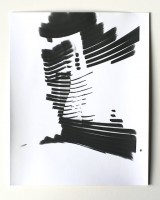works on paper (2012 and ongoing)
fiber-based 8"x10" photographic paper
in this continuing series, the quality of line, shading, thick fiber-based paper and scale recall drawing, bringing it into dialogue with cwm's photographic process. as in most of his other photographic work, cwm builds machines to move light slowly through space. using long exposures of often more than an hour, the camera he constructed especially for this series records these "performances" directly onto 8"x10" photographic paper instead of negative film. thus, when the paper is developed, the caresses of light from the machines produce black lines on a white ground rather than white or red/colored lines on a black ground, as in his instant photographic pieces or the 22" x 22" works for the New. New York show at the Essl Museum in 2012.
the single "scientific" lenses used in the camera, provide no image correction (as compound photographic lenses do) so we see large optically dissolving bands of rough black with the texture of spray paint, stretched edges and other distortions. these optical aberrations are some of the only clues to the viewer that she is looking at a photographic object.
many aspects of the work undermine the assumption that photography is an objective tool for mechanically reproducing a moment of the world as we see it. the abstraction resulting from these simple lenses, the strange reality of an extreme telephoto lens (as used for some of the pieces in this series), the fact that each of the works is a singular object with no negative to reprint from, and the highly extended duration of the process. yet the images remain, despite the tendency towards abstraction, the archive of light in a space.
photography is always, in some sense, literal. the direct recording of light. in this sense, the optical is always faithful or even truthful. but it is its own truth. one very different from our own experience of the world, though this difference is so often concealed by the near-instantaneous shutter speeds and techniques of conventional photography. it is not a human truth.






